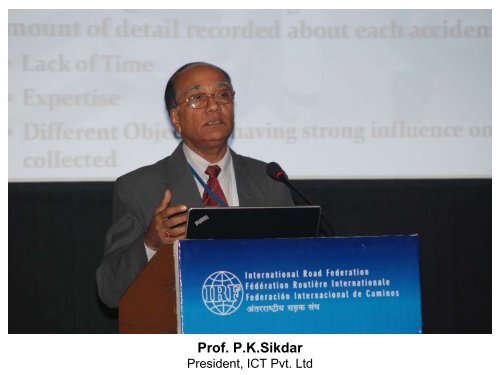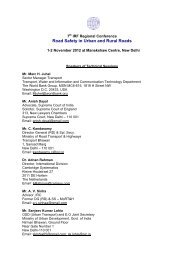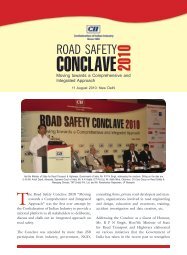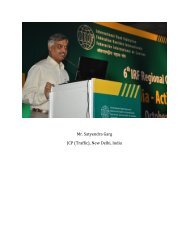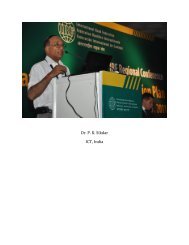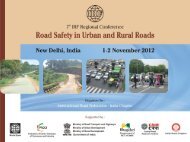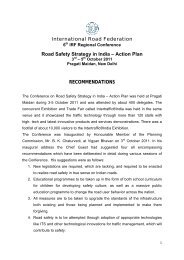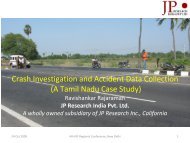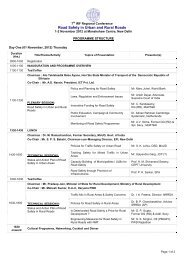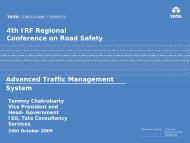Prof. P. K. Sikdar, ICT Pvt. Ltd. - IRF India chapter
Prof. P. K. Sikdar, ICT Pvt. Ltd. - IRF India chapter
Prof. P. K. Sikdar, ICT Pvt. Ltd. - IRF India chapter
You also want an ePaper? Increase the reach of your titles
YUMPU automatically turns print PDFs into web optimized ePapers that Google loves.
<strong>Prof</strong>. P.K.<strong>Sikdar</strong><br />
President, <strong>ICT</strong> <strong>Pvt</strong>. <strong>Ltd</strong>
By<br />
<strong>Prof</strong>. P.K.<strong>Sikdar</strong><br />
Advisor, <strong>IRF</strong> <strong>India</strong> Chapter<br />
President, <strong>ICT</strong> <strong>Pvt</strong>. <strong>Ltd</strong>
Integration for Effective Road Safety<br />
Program<br />
Education<br />
Engineering<br />
Enforcement<br />
Evaluation
Integration for Effective Road Safety<br />
Program<br />
Integration of 3 Es through encouragement of 3Cs amongst<br />
involved agencies<br />
• Cooperation - Development of<br />
joint road safety priorities<br />
• Coordination - Sharing of road<br />
accident information<br />
• Collaboration – Development of<br />
joint solutions for specific road<br />
safety issues
Importance of Crash Data for<br />
Proposing Countermeasures<br />
• To tackle road safety issues in a region<br />
• Complex countermeasures can be proposed, developed<br />
and implemented ranging across the 3 Es<br />
• Engineering,<br />
• Education and<br />
• Enforcement<br />
• Road crashes are multi-factorial event<br />
• Solutions can come from a wide range of agencies,<br />
organisations, community, and commercial sources etc.<br />
– all are having different needs of the accident data
Importance of Crash Data for<br />
Proposing Countermeasures<br />
Phase/<br />
Countermeasure<br />
Human<br />
Behaviour<br />
Road &<br />
Environment<br />
Vehicle &<br />
Equipment<br />
Pre-Crash<br />
Driver<br />
education<br />
Skid resistant<br />
surface<br />
ABS Braking<br />
In-Crash<br />
Wear seat belt<br />
and helmet<br />
Roadside<br />
hazards to be<br />
removed<br />
Crush zones<br />
&<br />
Air bags<br />
Post-Crash<br />
First aid<br />
training<br />
Access to<br />
emergency<br />
services<br />
Emergency<br />
services
Research and Evaluation<br />
Good crash data will support road safety through<br />
Research<br />
- problem identification<br />
- potential program solutions<br />
- development of policies<br />
- countermeasure development<br />
Evaluation<br />
- responses to countermeasures<br />
- comparisons and prioritization<br />
of initiatives<br />
- prediction of success for the future
Accident Data Collection Process<br />
•The accident record presently is being maintained by<br />
the police department in the form of FIR. This is NOT<br />
accident data record<br />
•Each police station records the details of the accident<br />
which take place within the area in its jurisdiction<br />
•Data is consolidated in SP's office in district HQ for<br />
record<br />
•Shortcomings: Lacks the right balance between the<br />
amount of detail recorded about each accident due to<br />
- Lack of Time
Proposed Accident Data Recording &<br />
Management System<br />
Road crash data systems generally will have four<br />
major components<br />
• Crash Data Collection and Recording<br />
• Data Storage and Retrieval,<br />
• Process of Accident Analysis<br />
• Method for Reporting and<br />
Distributing Data<br />
Please Note: If the data is not collected at the<br />
first instance, there is no second chance to<br />
collect the data from accident scene
Accident Recording & Management<br />
System
Proposed Accident Data Recording &<br />
Management System<br />
‣ Crash Data Collection & Recording<br />
‣ Database Requirement<br />
‣ Accident Location Possible Outcomes<br />
‣ Data storage, retrieval and analysis<br />
‣ Road safety information reporting<br />
‣ Administration and tools module
Proposed Accident Data Recording &<br />
Management System<br />
‣Crash Data Collection & Recording<br />
Information required to be completed at the scene on an easy-tocomplete<br />
format or a hand-held device like PDA<br />
Single form designed for all purposes<br />
Computer coded data format<br />
‣Database Requirement<br />
The nature of accident<br />
•Time of occurrence<br />
•Place of occurrence<br />
•Severity of outcome<br />
•Those involved<br />
•Vehicles involved<br />
•Prevailing conditions<br />
•Crash configuration<br />
•Site conditions/layout<br />
•Cause of accident<br />
Road features & operating controls<br />
•Road type<br />
•Road width<br />
•Shoulder width<br />
•Road geometry<br />
•Intersection characteristics<br />
•Speed limit<br />
•Road lighting<br />
•Road surface condition<br />
•Traffic control devices
Proposed Accident Data Recording &<br />
‣ Accident Location - Possible Outcomes<br />
Accident characteristics to be meticulously collected at crash sites<br />
An accurate and precise accident location is a critical characteristic to<br />
obtain reliable results from accident analysis studies<br />
Two forms of error possible - one associated with the actual physical<br />
location of the crash, second with the recording of that location<br />
Physical site<br />
identification<br />
Management System<br />
Transfer of location<br />
data to database<br />
Location<br />
Outcome
Proposed Accident Data Recording &<br />
‣Data Storage, Retrieval and Analysis<br />
Storage of the collected accident data in GIS platform<br />
• Data analysis<br />
Various analyses include<br />
• Cross Tab Analysis<br />
• Stick Analysis<br />
• Kilometre Analysis<br />
• Collision Diagram generation<br />
• Dynamic Query Builder<br />
Management System<br />
• Reports based on<br />
• Type of area<br />
• Time<br />
• Weather conditions<br />
• Road conditions<br />
• Day of the week<br />
• Vehicle types<br />
• Passenger causality<br />
• Pedestrian casualty.
Proposed Accident Data Recording &<br />
Management System<br />
‣ Road Safety Information Reporting for various<br />
Stakeholders/Agencies<br />
• National Safety Council<br />
• MoRTH, NHAI, State PWDs, State MVDs<br />
• CRRI, Regional Research Institute, IITs , Engg. Colleges<br />
• Health Depts - Central and State<br />
• Ministry of Human Resources - State Education Dept.<br />
• Ministry of Law, State Law Depts.<br />
• National Crimes Bureau<br />
• <strong>India</strong>n Roads Congress, International Road Traffic and Accident Database<br />
• Ministry of Statistics<br />
• Insurance Companies, Vehicle Manufacturers
Proposed Accident Data Recording &<br />
Management System<br />
‣ Administration and Tools Module<br />
• Administration Module<br />
• granting access rights<br />
• periodic back up file and distribution of data<br />
• Tools Module<br />
• importing digital maps<br />
• creating monitor areas<br />
• updating IRC crash and collision symbols<br />
• labelling the maps<br />
• Access to the main database application is to be<br />
restricted using user names, user groups and password
Main Features of the Application<br />
• Multi-lingual capabilities – based on programmed<br />
built-in menu and capability of addition in menu<br />
• Support for multiple databases<br />
• Support for multiple GIS & GPS functions<br />
• Pictorial menu for accident types and collision<br />
diagram with vehicular movements<br />
• Link to police information system for FIR etc (with<br />
complete information)<br />
• Extensive support for all statutory national and<br />
international accident data reporting formats<br />
- to be extracted in separate data modules
Actions for Institutionalizing<br />
Accident Data Management System<br />
‣ Police Training<br />
• Provide training sessions<br />
• Have full time data specialists to provide initial support<br />
• Ensure Help/Guidelines are readily accessible and usable<br />
‣Ensuring accurate data entry<br />
• First Information Report (FIR) information, that is<br />
factual/immutable be transferred to the accident report<br />
extract<br />
• Have unique identifier linking FIRs to accident report<br />
extracts<br />
• Any ‘false case’ FIRs be identified and deleted from<br />
accident recording system and compiled separately
Actions for Institutionalizing<br />
Accident Data Management System<br />
‣Recording accurate<br />
location data<br />
• Use of GPS devices for precise<br />
location data<br />
• Use very basic GPS which<br />
provide coordinates (recorded<br />
automatically)<br />
• GIS maps linked to GPS<br />
locations (automatically)<br />
• Maps can be produced showing<br />
accurate road data location,<br />
district information, police area<br />
information etc.
Actions for Institutionalizing<br />
Accident Data Management System<br />
‣Use of the program by Police (including GPS function)<br />
for precise location data<br />
• Develop an extract of the accident report form<br />
which contains the required data fields for FIR, and<br />
all other information shall be optional<br />
• New accident data recording system will facilitate to<br />
extract mandatory fields consistent with the Police<br />
accident report requirements<br />
• Translation of the extracted form into accident<br />
report extract and ensure consistency
Actions for Institutionalizing<br />
Accident Data Management System<br />
‣Rollout across the country<br />
• Enter Back Data (2 Years)<br />
• Demonstrate how the<br />
system reduces the time to<br />
record crash data and<br />
faster use in analysis<br />
• Launch the program in<br />
limited sites where<br />
expertise is available<br />
(initially)<br />
• Expand it to whole country
Actions for Institutionalizing<br />
Accident Data Management System<br />
‣Administration<br />
• Organise sub-task groups with experts and stakeholders<br />
to take responsibility and respond to early teething<br />
problems<br />
• Establish linkage to researchers and technical colleges<br />
with graduate students/staff to provide ongoing support<br />
‣Procurement/Provision<br />
• Hand-held device with built-in GPS location recorders<br />
for all police stations<br />
• Provisions for data handling experts for FIR data<br />
extraction (for initial periods)<br />
• Provision of computer systems, printers and web access
Thank You


